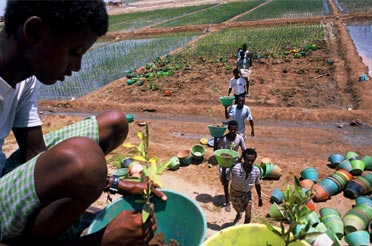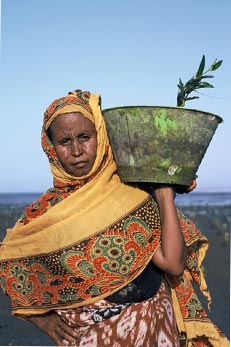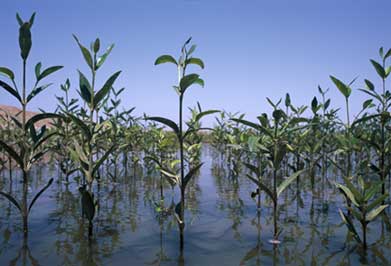
Main Menu-The Manzanar Project
(view as pdf-contains additional illustrations)

Gordon Sato United States Laureate 2002
Driven by a long-standing desire for justice, American biologist Gordon Sato is spending his retirement helping some of the world’s poorest people, in Eritrea, to help themselves. His innovative Manzanar project harnesses two of the Eritrean coast’s most abundant resources – intense sunlight and seawater – to grow mangrove plants that can be used not only to feed animals, but also to provide a habitat for fish and shellfish. His aim is to help impoverished, coastal communities in this war-torn country to develop a low-tech, sustainable agricultural economy.
An eminent
biologist and the author of more than 150 scientific publications, Gordon Sato
has dedicated much of the past 10 years – and $400,000 of his own money – to
establish a multi-faceted agricultural programme in Eritrea, with the
cultivation of mangroves as the main activity.
For his determined efforts to help Eritreans make positive use of their
challenging environment, Sato, an energetic and imaginative 74-year-old, has
been selected as a Rolex Laureate.
The reasons for Sato’s commitment to Eritrea date back to the 1980s and even
further. During the Second World War, the United States government held Sato, a
teenager at the time, and his Japanese-American family in Manzanar, an
internment camp in the Californian desert. Four decades later, during the last
few years of Eritrea’s 30-year struggle for independence, Sato recognised
parallels between the way Ethiopia was dealing with its Eritrean minority and
the treatment meted out to his own family during the war.
Eager to help the Eritreans, and prompted by news reports of a famine affecting
them, Sato went to Eritrea and set up a small, fish-farming operation in the
north of the country, near the Eritrean navy’s headquarters. This scheme, which
Sato named Manzanar in memory of his family’s war-time experience, provided
wounded troops with a much-needed source of protein.
When he first arrived in Eritrea in 1985, Sato’s initial reaction was “outrage
at the injustice of the situation. The Eritreans were being starved and
massacred. Upon meeting the Eritrean leadership for the first time, I was
impressed by their intelligence and highly principled commitment to freedom for
Eritreans.”
From then on, Sato returned frequently to Eritrea. On retiring in 1992, he chose
to spend six to eight months of every year there. Since then the Manzanar
project has become an impressive, non-profit initiative that could soon be
providing fodder to raise animals to feed up to 2,000 people.
Eritreans are proud people, highly selective in the development projects they
allow into their country. Sato admits spending almost as much time cultivating
the Eritrean authorities as he does his mangrove plantations. The Eritrean
Ministry of Fisheries initially allowed him to use small plots of land for
mangroves. Now, thanks to Sato’s diplomacy and his commitment to the country, he
has at his disposal expanses of barren inter-tidal land on the Red Sea coast for
the cultivation of mangroves and grasses.
Eritrea, which won independence from Ethiopia in 1993, is one of the world’s
poorest countries, with an annual per-capita income of $200. The areas adjacent
to its 1,000-kilometre coastline are particularly poor. The harbour town of
Massawa, where Sato runs the Manzanar project, is one of the driest places on
earth, receiving annual rainfall of less than two centimetres.
Mangroves, which tolerate salt water, grow along 15 per cent of Eritrea’s
coastline, forming a narrow fringe, normally no more than 100 metres wide. They
grow particularly well in mersas, places along this arid coastline where
seasonal rains collect for just a few days of the year and flow into the sea,
carrying large amounts of sediment.
 While
studying these areas, Sato and his co-workers – a team of young Eritrean
biologists and agriculture graduates – made an interesting discovery that
determined the direction of the Manzanar project. They realised that rainwater
and the sediment it carries contain the elements nitrogen, phosphorus and iron,
all of which are necessary for the growth of plants. These elements are also
present in seawater, but in insufficient concentration.
While
studying these areas, Sato and his co-workers – a team of young Eritrean
biologists and agriculture graduates – made an interesting discovery that
determined the direction of the Manzanar project. They realised that rainwater
and the sediment it carries contain the elements nitrogen, phosphorus and iron,
all of which are necessary for the growth of plants. These elements are also
present in seawater, but in insufficient concentration.
After much experimentation they devised a low-tech method of slowly releasing
these elements directly into seawater – by burying small, plastic bags of
fertiliser below the surface of the sand, next to young trees in tidal areas.
This fertiliser contains two of the “missing” elements – nitrogen and
phosphorus. The powder escapes very gradually through small holes pierced in one
side of the bag. Iron, the third vital element, is provided by wire netting and
pieces of metal, generally taken from the abandoned tanks, lorries and other
military ephemera littering the coast around Massawa. This combination of
elements enables mangroves to grow in otherwise barren inter-tidal areas.
The Manzanar project uses the native mangrove species Avicennia marina,
which provides excellent fodder for livestock.
The project team is also growing a second native mangrove species, Rhizophora
mucronata, which was previously almost extinct in the region because of its
popularity as construction lumber. This species is also used for firewood – very
important in a country where 75 per cent of domestic energy requirements are met
by burning wood.
After determining that the successful growth of mangroves depends on proximity
to a source of fertiliser, Sato and his team set about fertilising and
cultivating areas above the maximum tidal level. They are now planting mangroves
where they have never before grown, irrigating them with seawater pumped inland
along a network of pipes.
And while Sato and his co-workers have conducted experiments that prove goats
can survive on a diet comprising solely of Avicennia marina leaves, a
varied diet is better for the health of most animals. To address this, they have
planted the grasses Distichlis spicata and Spartina – both can be
irrigated with seawater and make excellent cattle fodder. They also plan to
cultivate the desert salt bush Atriplex which is high in protein and can
be used as fodder.
Robert Twilley, a professor of biology at the University of Louisiana, agrees
that mangrove leaves provide a good food source for livestock in a desert
environment. He maintains that mangroves can be cultivated in Eritrea, “as long
as Sato can keep the saltwater input constant and allow large amounts of
evaporation to overcome the salt balance”.
Sato is “absolutely confident” that this can be done. “Most of the planting is
in the inter-tidal zone, which is awash with seawater,” he explains. And in the
areas of cultivation further inland, the project’s seawater irrigation system is
working well, he adds.
In 2001, the Manzanar project grew about 60,000 mangrove seedlings at various
nurseries near Massawa, later successfully re-planting them near the coast.
Since then, Sato has shown that mangrove seeds can be sown directly into the
sand at coastal plantations.
 In
the 10 months to October 2002, Sato and the Eritreans he works with planted
about 200,000 mangroves, most of them at the village of Hargigo, 10 kilometres
south of Massawa. Sato and the Eritrean biologists provided technical advice and
training. The workers, most of them women, were paid for their labour during
this time.
In
the 10 months to October 2002, Sato and the Eritreans he works with planted
about 200,000 mangroves, most of them at the village of Hargigo, 10 kilometres
south of Massawa. Sato and the Eritrean biologists provided technical advice and
training. The workers, most of them women, were paid for their labour during
this time.
In 2003 the same workers will become farmers, continuing to grow mangroves and
harvesting them to feed livestock. Without a firm commitment by local people,
the scheme will fail, so they are being fully integrated into the whole
agricultural cycle.
The Rolex Award will help take Sato closer to his long-term goal of relieving
the Eritrean government of its financial support of the Manzanar project, which
currently stands at between $20,000 and $50,000 a year. In addition, it will
give a positive image of Eritrea.
Sato is
confident that local people will willingly participate, once they understand the
technology behind the Manzanar project and its potential impact. “They are
fishermen and shepherds,” he says, “and know the value of trees.” He is planning
to set up a feeding centre for animals on a five-hectare mangrove plantation
near to Massawa, so people can see the simple effectiveness of this technology
for themselves.
The residents of Hargigo are already reacting favourably to the project.
Concerned at first that villagers would not like the mangrove forests being
fenced off, Sato admits to being pleasantly surprised at their reaction. “They
love it,” he explains, “because periodically Rashaida nomads come through with
huge herds of camels, goats and sheep that eat everything in their path.” The
fences now protect the mangroves from such risks.
Sato maintains that the Manzanar project has had a profound effect on the
thinking of his young Eritrean colleagues who, he says, show great promise of
becoming future leaders of their country. “The simple methods they have
developed,” he says, “can be applied to desert areas worldwide – so countries
such as Somalia need never suffer famine again.”
He points
out that Manzanar serves two major purposes, “contributing to economic
development and to environmental enhancement”.
The originality of the Manzanar project stems from Gordon Sato’s simple, but
effective scientific methods, themselves borne out of a lifetime of confronting
– and systematically overcoming – all manner of difficulties. “I just keep
going,” he says, “I am unusually persistent.”
In addition to constantly refining his ideas, Sato’s creativity has proved to be
“an extremely valuable quality when working in a poor country”, says
distinguished biochemist Bruce Ames, from the University of California,
Berkelely. Ames has known Sato since they were both graduate students at the
California Institute of Technology, and has visited him in Eritrea.
Jesse Roth, a professor of medicine at Johns Hopkins University, in Baltimore,
points out that seawater, at first an obstacle, became the solution for the
Manzanar project. Such ingenuity, he adds, “is typical of Sato’s thinking”.
 “Introducing
low-technology agricultural methods to help the poor and arid country of Eritrea
holds hope for other developing coastal countries with similar climates.
Collaboration with young, Eritrean biologists and training of the local
population should promise long-term success for Sato’s project.”
“Introducing
low-technology agricultural methods to help the poor and arid country of Eritrea
holds hope for other developing coastal countries with similar climates.
Collaboration with young, Eritrean biologists and training of the local
population should promise long-term success for Sato’s project.”
Dr Laila El-Hamamsy
“The impact of Sato’s project is several-fold. Beneficiaries in Eritrea will
learn new techniques and improve their quality of life. At the same time, Sato
stands as a role model for scientists to show that one can, and should, apply
laboratory-based knowledge in a much wider world. Lastly, here is proof that you
do not have to be ‘bright young things’ to have an ingenious and workable idea.”
Baroness Susan Greenfield
“The
clarity of Sato’s vision, his determination to explore new ways of growing
mangroves in unfamiliar territory, his resourcefulness and ingenuity in
marshalling his knowledge and experience, accumulated over a lifetime, all
demonstrate an unquenchable spirit of enterprise.”
Mr Liu Thai Ker
“It is impressive that a renowned American biologist is working in his
retirement to help the people of Eritrea. His low-tech agricultural methods
present a concrete approach with immediate results. The project’s success will
be enhanced by his devotion to improving the quality of life of the local
people, his collaboration with young local biologists whom he has trained and
the support of government ministries.”
Prof. Chie Nakane
Dr Gordon Sato
Ministry of Fisheries
P.O. Box 18
Massawa
Eritrea
Email
manzanar@eol.com.er
or
manzanarmangrove@hotmail.com
© 1998-2006, Wallace L. McKeehan, All Rights Reserved